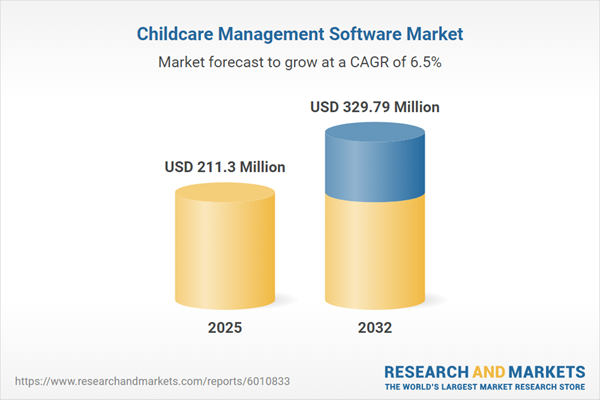Speak directly to the analyst to clarify any post sales queries you may have.
Childcare management software is reshaping digital operations across the sector, providing providers with the essential tools for compliance, streamlined communication, and improved organizational efficiency. Senior decision-makers are leveraging this technology to align business processes with evolving industry standards while fostering operational agility.
Market Snapshot: Childcare Management Software Market Size and Trends
The global childcare management software market is demonstrating consistent growth, valued at USD 198.52 million in 2024, projected at USD 211.30 million in 2025, and forecasted to reach USD 329.79 million by 2032, with a compound annual growth rate (CAGR) of 6.54%. This expansion reflects the increasing need for digital tools that simplify administration, deliver greater program transparency, and enhance interactions between families and childcare providers. High adoption rates are particularly evident in Asia-Pacific—driven by favorable policy updates and strong digital infrastructure—while other global markets are embedding these solutions as foundational elements of resilient and adaptable organizations.
Scope & Segmentation: Childcare Management Software
- Deployment Models: Options span cloud-based solutions such as SaaS and PaaS, as well as on-premise installations, enabling organizations to choose architectures matching their digital strategies and compliance obligations.
- Pricing Models: Subscription-based services and perpetual licenses facilitate flexible budgeting approaches, allowing providers to match technology spending with broader financial and procurement goals.
- Organization Sizes: Designed to serve solo practitioners, multisite childcare organizations, and all sizes in between, these solutions support customized workflows and scalable management tools.
- End Users: A diverse customer base includes daycare centers, preschools, after school facilities, kindergartens, home-based care, center-based operations, and nanny agencies, each benefiting from secure communication and efficient oversight capabilities.
- Core Application Areas: Software features encompass automated billing, advanced analytics, staff scheduling, regulatory tracking, and secure staff-family messaging, enabling optimized administration and fact-based decision-making.
- Geographic Regions: Solution adoption and feature requirements vary by geography, with distinct responses in the Americas, Europe, Asia-Pacific, Middle East, and Africa, shaped by differing regulatory guidelines and digital readiness.
- Key Companies: Sector leaders such as Procare Software Solutions LLC, Brightwheel, Inc., Jackrabbit Technologies LLC, HiMama, Inc., iClassPro LLC, Smartcare Software, Inc., Kangarootime, Inc., Kindertales Limited, Childcare Sage Inc., and Kinderlime LLC drive innovation by refining adaptability and specialized functionalities.
Key Takeaways for Senior Decision-Makers
- Mobile-first designs and cloud-based platforms support uninterrupted operations and regulatory adherence, helping organizations adjust quickly in response to new industry challenges.
- Advanced analytics and AI capabilities inform resource management, improve program outcomes, and guide longer-term strategic decision-making.
- Enhanced information security measures enable compliance with shifting regulatory requirements across multiple jurisdictions, safeguarding data and organizational reputation.
- Custom deployment and pricing flexibility empower organizations to scale technology as business needs evolve, ensuring minimal operational disruption during transitions or expansion.
- Integration with subsidy management systems and third-party solutions streamlines processes, offering stepwise upgrades from legacy systems and maintaining service consistency in regulated markets.
Tariff Impact on Supply Chains
Recent changes in U.S. tariff regulations are raising costs for providers sourcing imported technology elements. In response, many organizations are forming closer partnerships with local suppliers, adopting agile licensing models, and increasing reliance on cloud-based deployments. These strategies help maintain continuity of service and protect against potential market fluctuations.
Methodology & Data Sources
This report draws on a comprehensive methodology combining interviews and industry surveys with senior childcare leaders, technology-focused case studies, regulatory reviews, and funding analyses. The approach is designed to generate actionable intelligence for strategic organizational planning and investment evaluation.
Why This Report Matters
- Executive teams receive focused insight on evaluating, selecting, and implementing digital tools that enhance compliance and operational efficiency within tightly regulated childcare sectors.
- Organizations learn to navigate diverse regulatory and market landscapes, supporting customized digital transformation and sustainable long-term alignment.
- Informed market intelligence underscores prudent technology investment decisions by aligning resource allocation with organizational priorities and sector trends.
Conclusion
Childcare management software strengthens organizational reliability and compliance, supporting operational consistency for staff and families. Embracing digital technology remains key to sustained growth and strategic resilience in a fast-evolving industry.
Additional Product Information:
- Purchase of this report includes 1 year online access with quarterly updates.
- This report can be updated on request. Please contact our Customer Experience team using the Ask a Question widget on our website.
Table of Contents
3. Executive Summary
4. Market Overview
7. Cumulative Impact of Artificial Intelligence 2025
Companies Mentioned
The companies profiled in this Childcare Management Software market report include:- Procare Software Solutions LLC
- Brightwheel, Inc.
- HiMama, Inc.
- Kinderlime LLC
- Jackrabbit Technologies LLC
- iClassPro LLC
- Smartcare Software, Inc.
- Kangarootime, Inc.
- Kindertales Limited
- Childcare Sage Inc.
Table Information
| Report Attribute | Details |
|---|---|
| No. of Pages | 181 |
| Published | October 2025 |
| Forecast Period | 2025 - 2032 |
| Estimated Market Value ( USD | $ 211.3 Million |
| Forecasted Market Value ( USD | $ 329.79 Million |
| Compound Annual Growth Rate | 6.5% |
| Regions Covered | Global |
| No. of Companies Mentioned | 11 |









